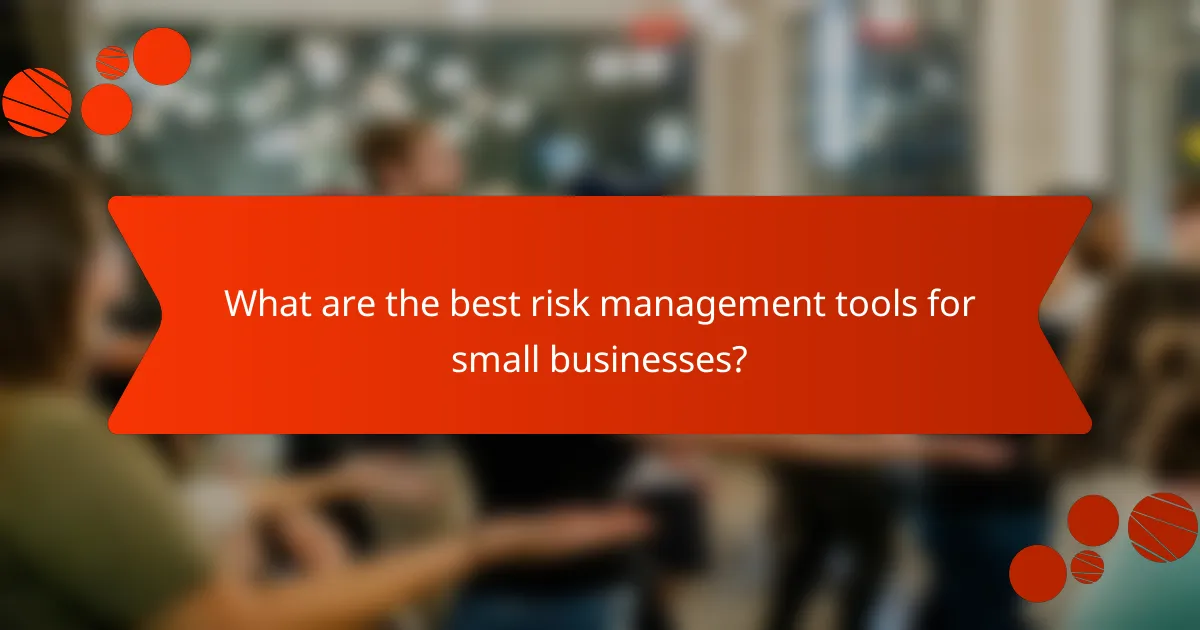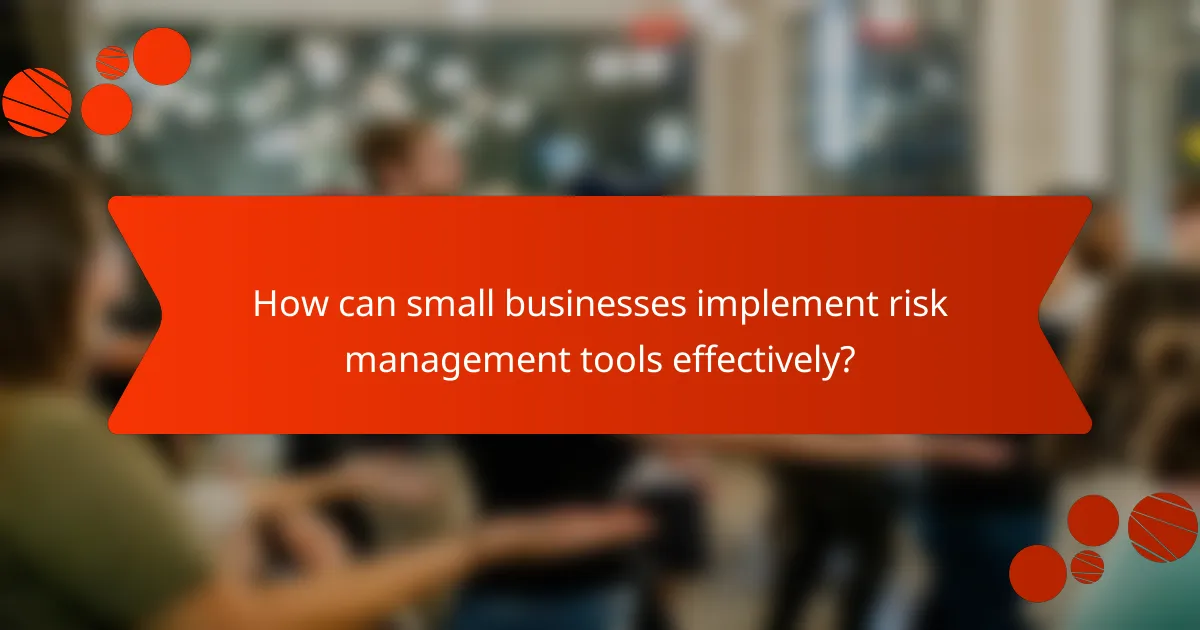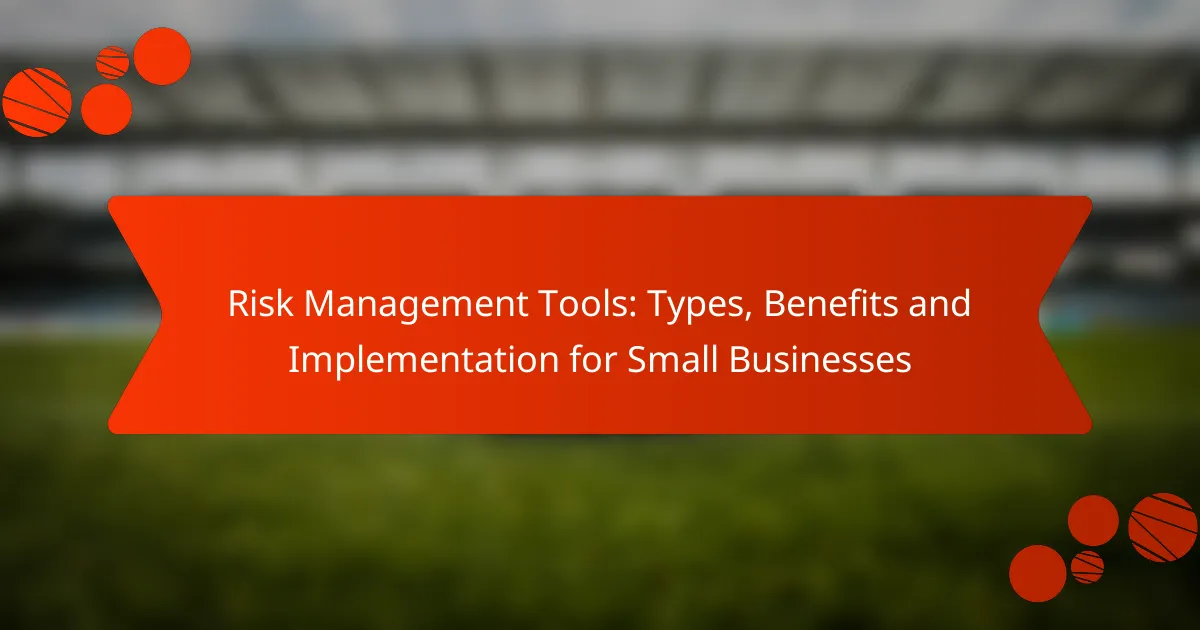Risk management tools are vital for small businesses, offering structured methods to identify, assess, and mitigate potential risks. By implementing these tools, businesses can enhance decision-making, ensure regulatory compliance, and protect their assets, ultimately fostering operational stability and resilience.

What are the best risk management tools for small businesses?
The best risk management tools for small businesses include software and platforms designed to identify, assess, and mitigate risks effectively. These tools help streamline processes, ensure compliance, and protect assets, making them essential for maintaining operational stability.
Risk assessment software
Risk assessment software enables small businesses to identify potential risks and evaluate their impact. These tools often provide templates and frameworks that guide users through the risk identification process, making it easier to prioritize risks based on severity and likelihood.
When selecting risk assessment software, consider features such as user-friendliness, integration capabilities with existing systems, and reporting functionalities. Popular options include RiskWatch and LogicManager, which cater to various industry needs.
Compliance management platforms
Compliance management platforms help small businesses adhere to industry regulations and standards. These tools track compliance requirements, manage documentation, and facilitate audits, reducing the risk of non-compliance penalties.
Look for platforms that offer customizable compliance checklists and automated reminders. Tools like ComplyAdvantage and ZenGRC can assist in maintaining compliance with regulations such as GDPR or HIPAA, depending on your business sector.
Incident management systems
Incident management systems are designed to document, analyze, and respond to incidents effectively. These tools help businesses manage incidents ranging from data breaches to workplace accidents, ensuring that appropriate actions are taken swiftly.
Choose a system that allows for easy reporting and tracking of incidents. Solutions like ServiceNow and JIRA Service Management provide robust features for incident tracking and resolution, helping to minimize disruption and improve response times.
Insurance management tools
Insurance management tools assist small businesses in managing their insurance policies and claims efficiently. These tools help track coverage, premiums, and claims history, ensuring that businesses have adequate protection against potential risks.
Consider platforms that offer policy comparison features and reminders for renewals. Tools like CoverWallet and Insureon can simplify the insurance process, making it easier to find the right coverage at competitive rates.
Data protection solutions
Data protection solutions safeguard sensitive information from breaches and unauthorized access. These tools often include encryption, access controls, and backup systems to ensure data integrity and compliance with regulations.
When selecting data protection solutions, prioritize those that offer real-time monitoring and incident response capabilities. Solutions like Veeam and Acronis are popular among small businesses for their comprehensive data protection features.

How can small businesses implement risk management tools effectively?
Small businesses can implement risk management tools effectively by establishing clear objectives, assessing potential risks, selecting suitable tools, and training staff on their use. This structured approach ensures that the tools align with the business’s specific needs and enhance overall resilience.
Define risk management objectives
Defining risk management objectives is crucial for small businesses to focus their efforts on the most significant threats. Objectives should be specific, measurable, achievable, relevant, and time-bound (SMART). For instance, a business might aim to reduce financial losses from cyber threats by a certain percentage within a year.
Consider involving key stakeholders in this process to ensure that the objectives reflect the overall business strategy. This alignment helps prioritize risks that could impact operations, reputation, or compliance.
Conduct a risk assessment
A risk assessment involves identifying and analyzing potential risks that could affect the business. Small businesses should evaluate both internal and external factors, such as operational vulnerabilities, market fluctuations, and regulatory changes. This can be done through surveys, interviews, and reviewing existing data.
Once risks are identified, they should be prioritized based on their likelihood and potential impact. A simple risk matrix can help visualize this, categorizing risks as low, medium, or high priority to guide further action.
Select appropriate tools
Selecting the right risk management tools is essential for effective implementation. Small businesses can choose from a variety of tools, including software solutions for monitoring compliance, insurance products for financial protection, and training programs for employee awareness. The choice should align with the defined objectives and the results of the risk assessment.
For example, a business concerned about data breaches might invest in cybersecurity software, while another focused on operational risks may benefit from project management tools that include risk tracking features. Always consider the cost versus the potential benefits when selecting tools.
Train staff on usage
Training staff on the usage of risk management tools is vital for ensuring their effectiveness. Employees should understand not only how to use the tools but also the importance of risk management in their daily roles. Regular training sessions and workshops can help reinforce this knowledge.
Additionally, create a culture of risk awareness by encouraging open communication about risks and inviting feedback on the tools’ effectiveness. This engagement can lead to continuous improvement and adaptation of risk management strategies as the business evolves.

What are the benefits of using risk management tools?
Using risk management tools provides small businesses with a structured approach to identify, assess, and mitigate potential risks. These tools enhance decision-making, ensure compliance with regulations, minimize financial losses, and improve overall operational efficiency.
Improved decision-making
Risk management tools enable small businesses to make informed decisions by providing data-driven insights into potential risks. By analyzing risk factors, businesses can prioritize actions and allocate resources more effectively. For instance, a company might choose to invest in cybersecurity measures after identifying a high risk of data breaches.
Additionally, these tools often include scenario analysis features, allowing businesses to simulate various outcomes based on different risk scenarios. This foresight helps in crafting strategies that are resilient to unforeseen challenges.
Enhanced compliance
Compliance with industry regulations is crucial for small businesses to avoid legal penalties and maintain their reputation. Risk management tools help in tracking compliance requirements and ensuring that all necessary protocols are followed. For example, tools can automate the monitoring of data protection laws, such as GDPR in Europe or CCPA in California.
By systematically addressing compliance risks, businesses can reduce the likelihood of violations and foster trust with customers and stakeholders. Regular audits facilitated by these tools can further ensure ongoing adherence to regulatory standards.
Reduced financial losses
Implementing risk management tools can significantly lower the financial impact of unforeseen events. By identifying potential risks early, businesses can take proactive measures to mitigate them, such as purchasing insurance or diversifying suppliers. This approach can save businesses from costly disruptions.
Moreover, these tools often provide insights into risk exposure, helping businesses to allocate financial resources more wisely. For example, a small business might discover that investing in employee training reduces the risk of workplace accidents, ultimately saving on insurance premiums.
Increased operational efficiency
Risk management tools streamline processes by identifying inefficiencies and potential risks in operations. By automating risk assessments and reporting, businesses can save time and focus on core activities. For instance, a tool might highlight supply chain vulnerabilities, prompting a review of vendor contracts to enhance reliability.
Furthermore, these tools can foster a culture of risk awareness among employees, encouraging them to identify and report risks actively. This collective effort can lead to continuous improvements in operational practices, ultimately boosting productivity and profitability.

What criteria should small businesses consider when choosing risk management tools?
Small businesses should prioritize criteria such as cost-effectiveness, scalability, and ease of implementation when selecting risk management tools. These factors ensure that the chosen solutions align with the business’s financial capabilities and growth potential while effectively addressing their unique risks.
Cost-effectiveness
Cost-effectiveness is crucial for small businesses when selecting risk management tools. Evaluate not only the initial purchase price but also ongoing costs, such as maintenance and support. Look for solutions that provide a good balance between features and affordability, ideally falling within the low hundreds to low thousands of USD annually.
Consider free or low-cost options that offer essential features, especially for startups. However, be cautious of hidden costs that may arise from inadequate support or limited functionality, which could lead to higher expenses in the long run.
Scalability
Scalability ensures that risk management tools can grow alongside your business. Choose solutions that can accommodate increasing data volumes and complexity as your operations expand. Tools that offer tiered pricing or modular features can be particularly beneficial, allowing you to pay for only what you need at each stage of growth.
Assess whether the tool can integrate with other systems you may adopt in the future. This flexibility can save time and resources during transitions, making it easier to adapt to changing business environments and regulatory requirements.



